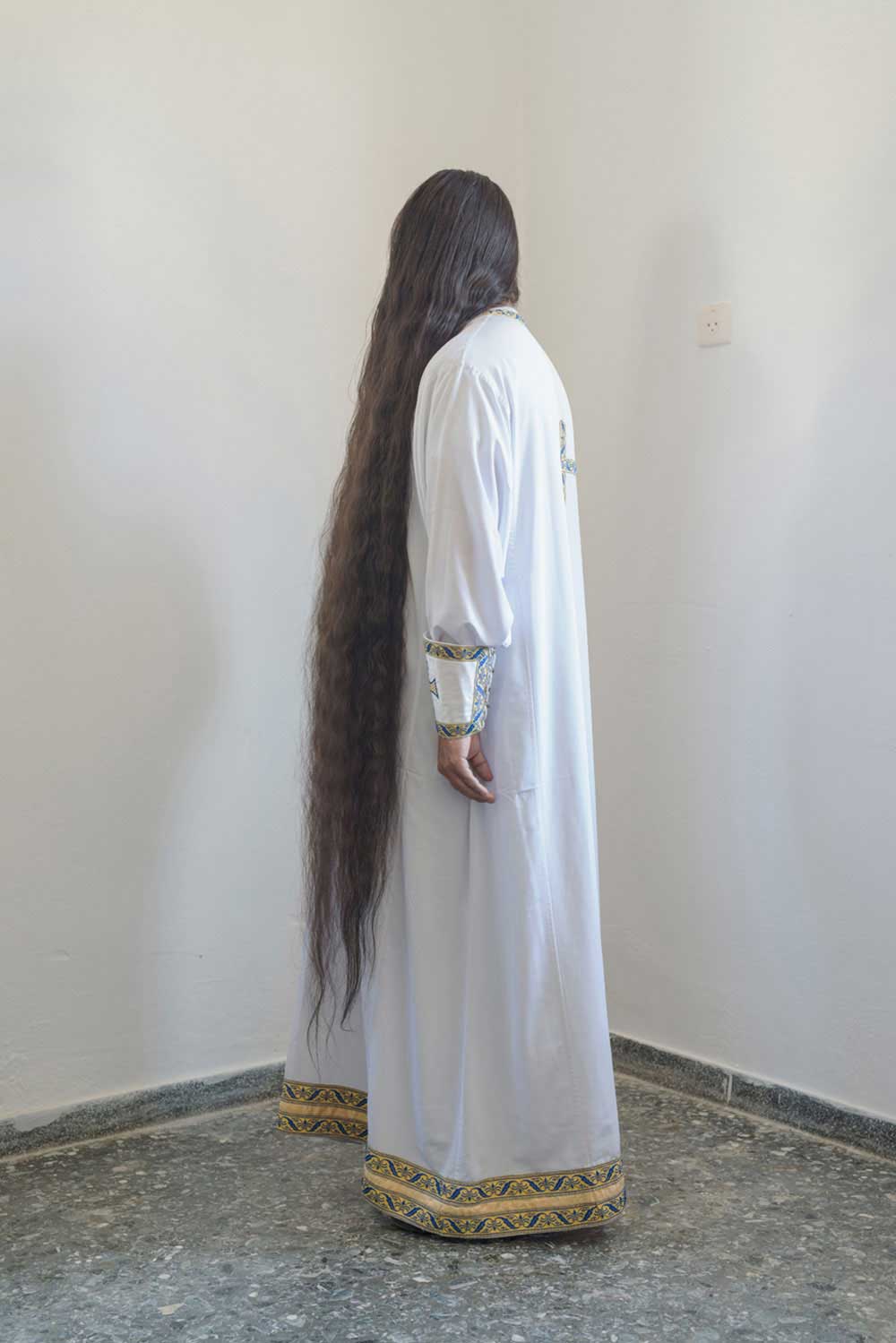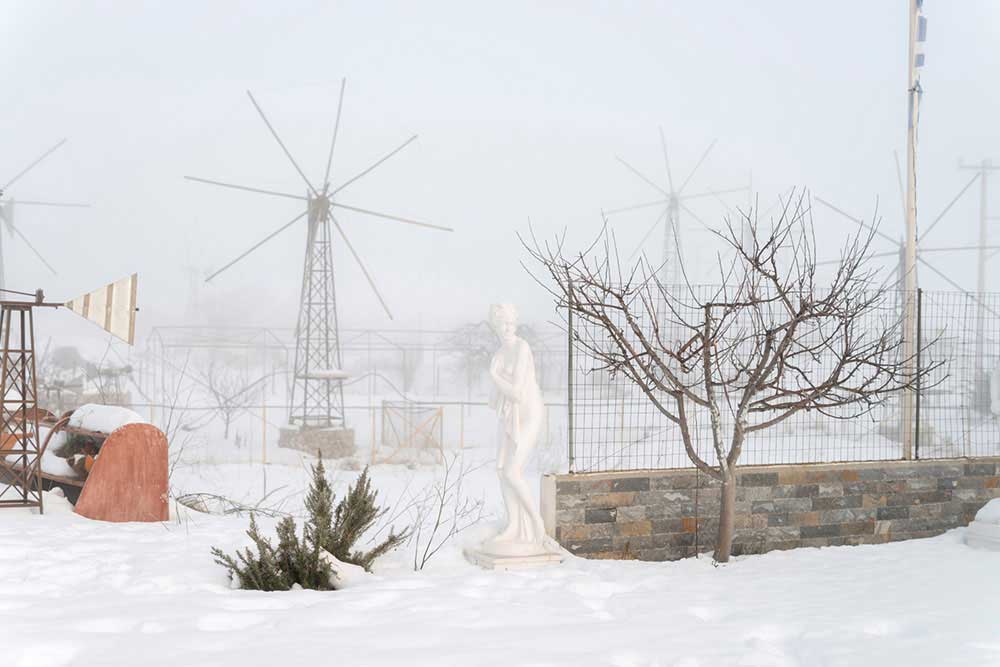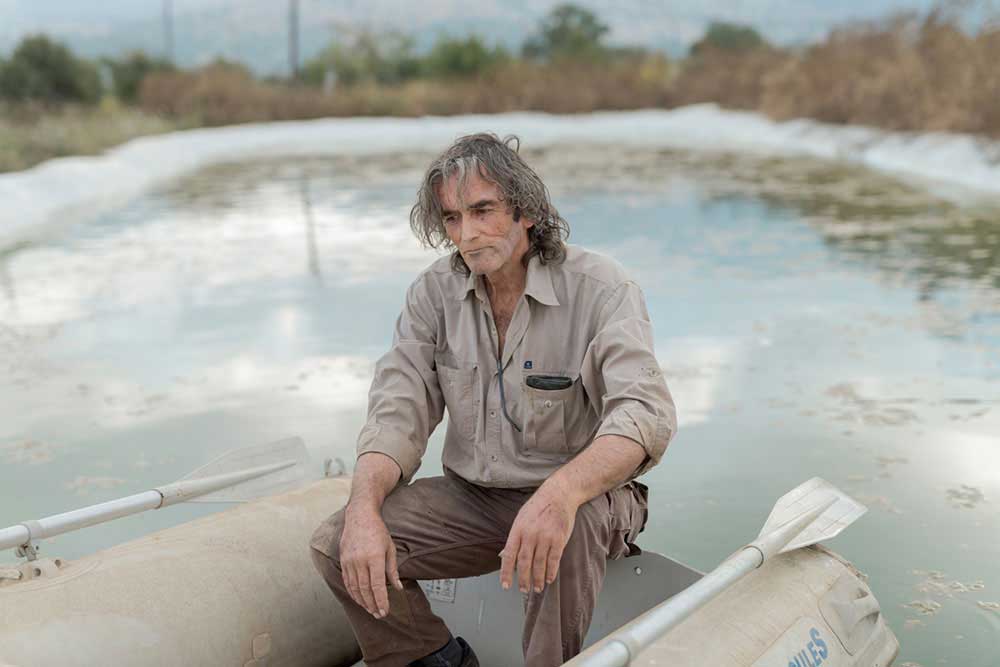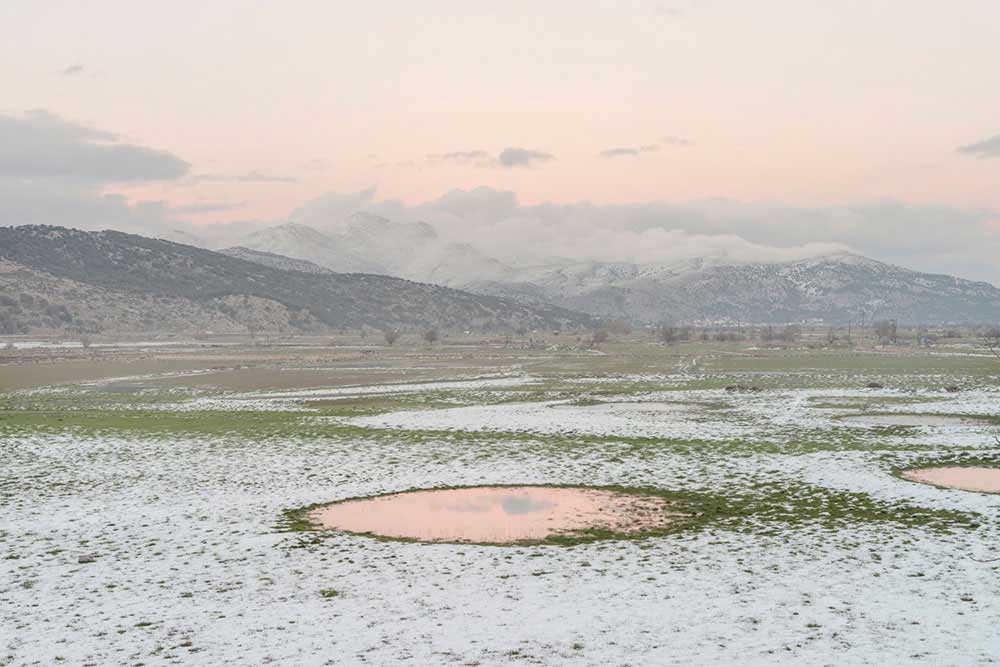Panos & Mary is a photographic duo, and this is not their only unusual feat. These Greek islanders belong to the new documentalists. They portray realities through poetic images in pastel color fantasies.
Their portraits and landscapes share a common dreamy mood, like in a trance. They use photography to address social existence from a human perspective glorying their subjects with respect and dignity. In order to understand their works, I´ve asked them about their notion of working together in a commonly individualistic technique, their prestigious series Cornucopia, their approach to a school in Second Chance, and the beautiful contemplation of their Mother Motif. Actually, not their whole story, just the beginning to grasp their magical enigmas. Stay with me to immerse in Panos Mary’s world. [Official Website]
It’s something unusual to find a photographic duo. There must be great complicity between you. How is the process of photographing with another person? How do you both make decisions, divide, or set the tasks?
First of all, we would like to thank Dodho Magazine and you for giving us the opportunity to share our work and thoughts.
We have been working as a duo for more than a decade now. It was quite simple at first, and it felt right. Over the years, our artistic partnership is evolving, and it is really natural for us to collaborate. Whatever we decide to do is supported unanimously, otherwise, we do not proceed with it. That ensures that we both retain the same deep interest in each project. On a more practical level, we shoot together, edit together, and sequence together. However, one of us focuses on the process of developing and the other on the printing process. We do this to achieve homogeneity. Producing artwork that we feel is coherent and unique is essential, as a successful partnership is not about doing something better but delivering something different. We think our photography is representative of who we are, and our artistic duo must give the impression of a single being.
Mary holds an MA degree in Graphic Arts and Panos has a Ph.D. in Environmental Engineering, how has education influenced your works?
At first, it may seem like an odd combination. Mary’s MA included theories of vision and perception, which are related to formal photography education, while Panos for his Ph.D. designed a camera system for scientific purposes. What we did during this period introduced us to photography.
Additionally, we both received formal education (BSc) on hard sciences. This fact affected the way we see and understand the world. Photographs function in two ways: they can be seen as pieces of evidence and, at the same time, trigger an emotional response. This inherent duality is valuable for experiencing and understanding reality.
The hard sciences are suitable for investigating the absolute truth. To do this, they persistently eliminate the human factor, as it can be a source of error. There are, however, some cavities in this approach, firstly not everything can be described by disregarding the observer, and secondly, any conclusion to be meaningful has to be communicated back to people. The arts and photography, in particular, may be appropriate to describe realities that only become apparent when the human perspective has to be considered.
Our education also influenced our work strategy. Every time we come up with a new idea for a project, we first start by researching to come up with a theory that acts as a guide. The application of any theory inevitably involves some level of conceptual practice. It may not always be obvious, but most of our works have a conceptual layer in them.
Panos & Mary belong to the new documentalists, interested in the representation of social realities from a poetic viewpoint. Do you feel there is a move towards this way of understanding photography these days and how did you get involved in this?
We consider the poetic aspect of our artwork valuable, as we believe it is a manifestation of our perishable nature as beings. At the same time, we feel reluctant to abolish the documentary aspect of our work. To quote Szarkowski: “as an organism, photography was born whole”; through photographic history, various photographers have contributed to the expansion of our understanding of the medium, emphasizing and exploring various aspects of it. Through this process, the arsenal that practitioners have at their disposal has extended. We are willing to embrace different methods that serve our projects. New documentalists take a more holistic approach, to the degree that this is possible. This attitude, however, is not surprising, given the plethora of artistic expressions to which any photographer is exposed. We feel that our involvement happened slowly over time, mostly driven by the needs of our projects, and of course, other artists we like and admire, influence us.
Like Martin Parr, you have a good collection of photography books. You seem to be proud of this. Today some people may consider it a bit romantic. How do you get the books? and how do you feel about creating your own books?
We do love photo books! Photobooks are often the perfect way for photographers to present their work and have a unique and lifelong interaction with the viewer. Owning photobooks is essential for us. They can be an excellent source of inspiration and are often part of our research. We purchase the books from any possible source, directly from the photographer, a bookstore, or the publishing house. We mostly discover new books through the internet and, in many cases, through social media. Another way is photobook fairs or exhibitions, where one might also meet the author in person.
We consider photo books to be beautiful objects worth admiring and making one can be a creative experience. However, making a photobook can be a difficult task. First, you need to think about which style suits your project, and you need to define your target audience and your budget. An expensive production will not necessarily be the best choice for any style or subject of the artwork. One must also consider that the plethora of photobooks available leads to competition. An expensive photobook may have lavish prints, but the price itself will potentially discourage people from buying it. Designing a book is a balancing act that also involves compromise. We feel that the most frustrating thing is precisely these compromises. You always try to do as little as possible, and there are creative ways to overcome any difficulties, but in the end, some compromises are inevitable.
In Cornucopia, you show the old and new mythological stories about the Lassithi plateau in Crete. There is a strong connection to the landscape and the people, the images work like verses in a poem. The delicacy of the pastel colors and the sweet approach to the subjects and places point in a subtle and respectful direction. The project also plays with the unexpected and with beauty. People and landscapes share a mood, like in a trance. Tell me some nice unknown anecdotes from Cornucopia.
We first visited the Lassithi plateau more than a decade ago and have continued to return ever since. “Cornucopia” originates from our curiosity to understand the fixation we have for this place. We feel that this agrarian world up in the mountains is a personal fortress, a kind of safe space. While investigating “Cornucopia” we started to create a social life there, and many of the portrayed people are considered friends. Gradually, our connection to the plateau became so strong, that at some point, we were thinking of buying a small house there.
Cornucopia is not the first project we did on the plateau. The first was “Gardens of Oblivion” which has completely different aesthetics and subject matter. This transition between the two projects is also representative of our course in photography. We grew up photographically while shooting the plateau, and that meant we silently restarted the project more than once. After all those years, we have gathered so many images and stories that it became difficult for us to put a closure. Luckily, we attended a workshop with Alec Soth during the MedPhoto Festival. A conversation we had with him helped us clarify all the clatter. We then returned to the plateau with a clear vision of what we wanted and completed the project.
“Cornucopia” has three parts that may not be obvious to the viewer. The first part is a small study of the plateau’s scenic representation that serves, in parallel, as an introduction. The second part is related to the mythological – magical aspect of this place. In the third and final part, we use the fall of man and the expulsion from the Garden of Eden to reference the severe depopulation problem of the plateau, leading our narrative to a kind of dramatic climax. A conversation we had with a close friend of ours, who is a monk, inspired us for the last part.
How has this project changed your lives after all the recognition it has received? Can you see a second part? Is there something left behind in Lassithi you would like to work in?
We are happy that “Cornucopia” had this acceptance from the photographic audience. We do what we love, and when our work is somewhat recognized, it brings us great joy. The exposure “Cornucopia” had, did not profoundly change our lives. Any recognition we got gave us more confidence and courage to continue our photographic course.
Regarding the project itself, we feel that right now it is completed, and we have no immediate plans to start a second part, but of course, no one can be sure of anything. However, we believe that we need to move forward with our work, as there are other photographic projects that we are working on, as well as new ideas that we are currently considering.
In Second Chance, we find another social documentary series, this time about Second Chance School of Mytilene. There is a clear intention to represent each person, students, or teachers, with the identity and affection you felt from them. It’s a human approach to photography. The colors and the unexpected elements add force to the set once more. How was your experience at school?
It was an amazing experience! We were given the opportunity to meet remarkable people who were striving for a better future for themselves and their families. During this project, we had the support of the school principal, a very kind and sensitive man. Our intention was to record the stories and efforts of these people, especially the students, but also their teachers, through a more personal relationship. To further deepen our involvement there, we also voluntarily organized regular photographic courses for those students who were interested. That helped disseminate the spirit of our work among the students, and it was a way to give back something to the community that cordially accepted us. In many ways, it felt like we were going back to school again.
Again, in Mother Motif, you made the magic. It’s so sensitive, emotional, and refined how you represent a Mother’s Love. Though the presentation is quite colorful, there is a contained pastel color choice that makes the series quite special. How was the process of work for Mother Motif?
We always felt that any project related to the concept of family is difficult to implement. That can be attributed to the inevitably private nature of such work and to the fact that we already have established views of our closest relatives prior to photographing them. The “Mother Motif” was created during the COVID-19 lockdown, when we came closer to Mary’s parents, as they had to stay home. It started as a recording of Mary’s mother’s favorite items. As we moved on, she showed us more and more items (like fabrics), given to her by her mother, her grandmother, and her great-grandmother. We decided that the project should focus on the relationships that are developing between mother and daughter, as well as the patterns of behavior that are passed down from generation to generation, amongst the women of the family. The color palette was already present in the mother’s objects and was chosen as the most suitable for the realization of the project.
We are currently working on creating an accordion photobook. We believe that this form is best suited for the core idea of “Mother Motif”, as it creates a continuous space full of evolving patterns. This book will be handmade by us fine-art objects, and we consider it to be the final deliverable of the whole project.
There is a generosity quality in the platform you created called “The Provinces” to share works that deal with the Greek periphery. One of the purposes of “The Provinces” is encouraging others to create and portray in the countryside, out of the center. I must say the selection is intriguing and quirky, but with a sense of calmness under a spell. Tell me about the connections among this collective.
“The Provinces” is a platform that catalogs and showcases photographic projects related to provincial Greece. Although we do not exclude photographers residing in urban centers, many of the projects come from photographers living in small towns or rural areas. We do not wish to impose any aesthetics on the selected artwork, but rather embrace the underlined divergence of expressions. We believe that this plurality is a crucial part of a featured project, as it reflects the photographers’ background, course, and inevitably their relationship with their subject.
The platform was co-founded and run by eight people, including us. It runs voluntarily, and everyone chips in from their spare time. The members who are responsible for the operation of the platform come from different parts of Greece, and we rarely meet in person; we heavily rely on the Internet. Since each one of us might have different priorities, we vote for the major decisions, but for everyday tasks, we are free to act according to our will. Over time, we discovered that this flexible structure works best and suits the previously described limitations.
Finally, what is your relationship with social media?
Social media is essential and can be invaluable. They form communities that extend far beyond the borders of a country and offer the opportunity to introduce your work to a wider audience. In addition, social media is an indispensable tool that supports the operation of an artist’s website. Saying this, social media has its own rules and limitations. The featured work has to be presented in a compact manner suitable for fast consumption. Accompanying texts should be small, preferably shrank into a single catchphrase, with emphasis on individual images rather than sequences. Furthermore, many users find themselves “zapping” among an immense number of images, instantly reaching a verdict, which is usually an oversimplistic “like” or “dislike”. Interacting through social media requires considerable time and effort that might be taken away from other important tasks. As artists, we try to balance our limited time between creation and social media. Nevertheless, one can always discover very interesting artists and their work via social media.
For this critic, this couple is easily up there among the best photographers these days. Their tendency to find intricate topics and present them in strange but charming ways make them absolutely interesting to discover. In an intoxicated world full of negative news, we rejoice in learning real stories from idyllic images far from destruction and closer to heavens. For sure we can relate to their nice state of affairs.
Seigar
Seigar is a passionate travel, street, social-documentary, conceptual, and pop visual artist based in Tenerife, Spain. He feels obsessed with the pop culture that he shows in his works. He has explored photography, video art, writing, and collage. He writes for some media. His main inspirations are traveling and people. His aim as an artist is to tell tales with his camera, creating a continuous storyline from his trips and encounters. He is a philologist and works as a secondary school teacher. He is a self-taught visual artist, though he has done a two years course in advanced photography and one in cinema and television. His most ambitious projects so far are his Plastic People and Tales of a City. He has participated in several international exhibitions, festivals, and cultural events. His works have been featured in numerous publications worldwide. His last interests are documenting identity and spreading the message of the Latin phrase: Carpe Diem. Recently, he received the Rafael Ramos García International Photography Award. He shares art and culture in his blog: Pop Sonality.














